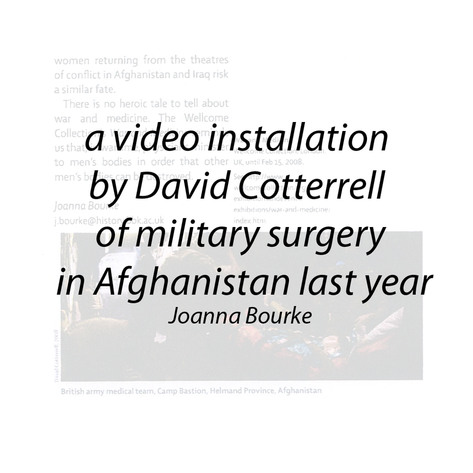Lancet : The complexity of medicine and war
Publication Title: LancetPages: 115,116
Writer: Joanna Bourke
Publication Date: 10th January 2009
There is horror inscribed on the body at war. As one infantryman scrawled in a scrapbook being passed around the wards of a ·convalescent hospital during World War I, "the sights cannot be explained in writing. Writing is not my line. No fighting either For them that wants to let them fight Because I will never like it no no never". When faced with the mutilated, agonised, and contorted flesh of combat, there is only terror. As the World War II poet and combatant, Shawn O'Leary, expressed it in his poem of 1941:
"And I -
I mow and gibber like an ape.
But what can I say, what do?
There is no saying and no doing,"
Attempts by physicians to alleviate the reality of dismemberment, disease, and psychological shock arising from war can only be limited. Near the start of the 1914-18 war, medical officers like James Henry Dible left England "filled with the anticipation of cutting off legs and arms upon the stricken field, amidst a hail of shrapnel and machine-gun bullets". Heroic acts of surgery and medicine would triumph against the corporeal havoc wreaked by combat. By the end of that conflict, however, the bitter reality had been exposed: the healing art had become a killing machine.
The Wellcome Trust has a long tradition of investigating this paradox. In December, 1914 - less than 4 months into a war that was to see some 703000 British men killed and about 1663000 wounded - the Wellcome Medical Museum opened an exhibition on “objects and relics" of wartime surgery. They boasted about the “rude instruments which surgery has at its disposal as a beneficent agent in war". A "fearful and wonderful assortment of amputation knives and saws", instruments to extract bullets, and tourniquets used to arrest haemorrhages were on display. Visitors to the exhibition were not to know that, within just 4 years, more than 41000 British men would have their limbs amputated by a "fearful and wonderful assortment" of knives, while many others would have bullets extracted and tourniquets applied to their war-torn bodies.
Today, when military personnel are fighting in Afghanistan and Iraq, the Wellcome Trust once again opens an exhibition on war and medicine. In their elegant exhibition space, the tensions between warmongering and the healing profession are explored with breathtaking realism. Organised in partnership with the Deutsches Hygiene-Museum in Dresden, Germany, War and Medicine focuses on conflicts from the Crimean War in the 1850s through to the present. There are over 200 objects, artifacts, and recordings, as well as a video installation, films, and art. The effect is astounding.
Not surprisingly, it is not for the faint-hearted. Visitors have to be prepared to view mutilated and diseased body parts, photographs of men without faces, graphic posters warning about venereal disease, and a video installation (by David Cotterrell) of military surgery in Afghanistan last year. The curators are careful to acknowledge complexities. Not all wars are the same. During the Crimean War, for instance, more men died from disease than from shot and shell. The body is not only decimated by war, it is also moulded by it. Major public health campaigns were directed at civilians, resulting in some striking posters and amusing postcards. There are also poignant reminders of men's need to impose some kind of order in the confusion innate to war. Thus, one soldier who died on the Western Front during World War II carried around with him a tiny collection of grooming products: a toothbrush, shaving brush, nail scissors, and a mirror.
Most confronting, however, were the sections on psychiatric breakdown. 25% of all discharges in the British forces during the 1914-18 war and between 20% and 50% during the 1939-45 war were labelled "psychiatric casualties", In Korea, combatants were twice as likely to become psychiatric casualties as to be killed by enemy fire. During the war in Vietnam, the language of psychological trauma was co-opted by perpetrators of violence. Although now widely accepted as a medical disorder, the invention of post-traumatic stress disorder in the 1980s was viewed by some, for example Allan Young in The Harmony of Illusions: Inventing Post-Traumatic Stress Disorder, as a mechanism that allowed individuals who had tortured and killed Vietnamese women and men to be portrayed (and to portray themselves) as victims of trauma. In this exhibition, there is a disconcerting film of traumatised veterans of the Vietnam war admitting to committing atrocities, eerily transferring sympathy from their victims to themselves.
War and Medicine opened at an apt time. During World War I, the YMCA circulated a poster declaring "Don't pity a disabled man - find him a job". They were fighting a losing battle. During this war soldiers' mutilations were said to be "badges of their courage, the hall-mark of their glorious service, their proof of patriotism", but they were quickly forgotten and the Ministry of Pensions came to see their job as primarily one of limiting state liabilities. Today, injured and traumatised men and women returning from the theatres of conflict in Afghanistan and Iraq risk a similar fate. There is no heroic tale to tell about war and medicine. The Wellcome Collection's War and Medicine reminds us that, in wartime, physicians minister to men’s bodies in order that other men’s bodies can be destroyed.
Joanna Bourke
j.bourke@history.bbk.ac.uk
Download this file here, or click the image on the right.
Share:
Twitter / Facebook / Pinterest
